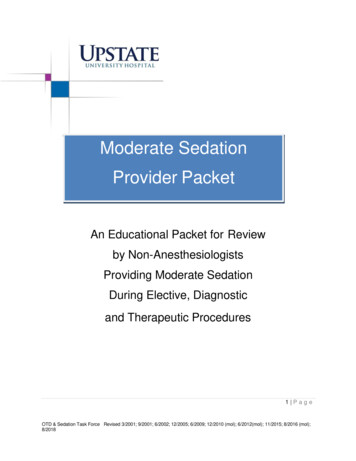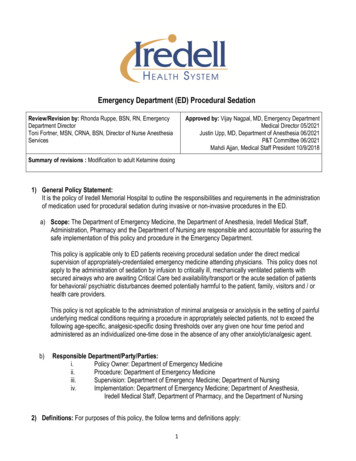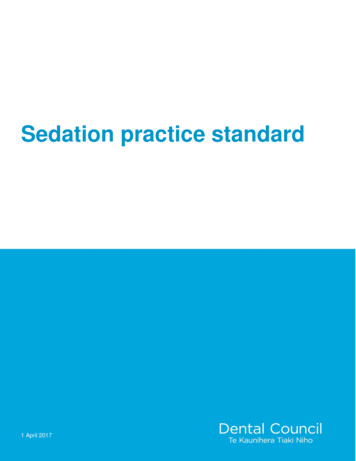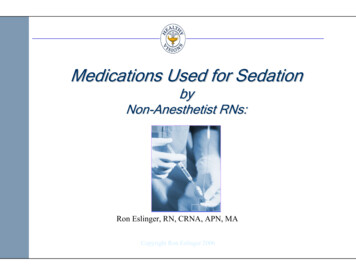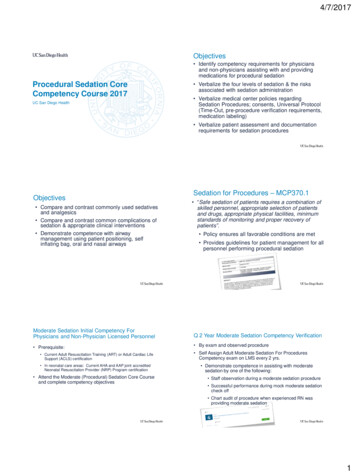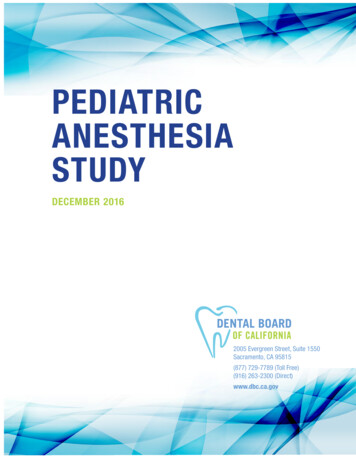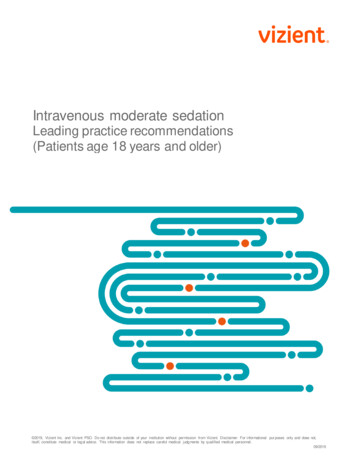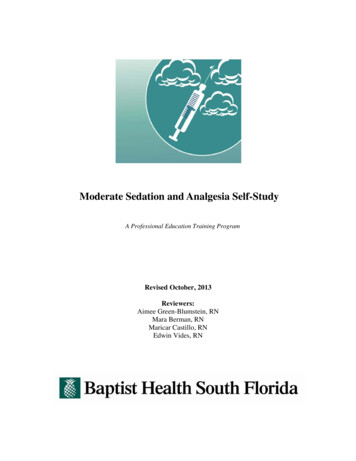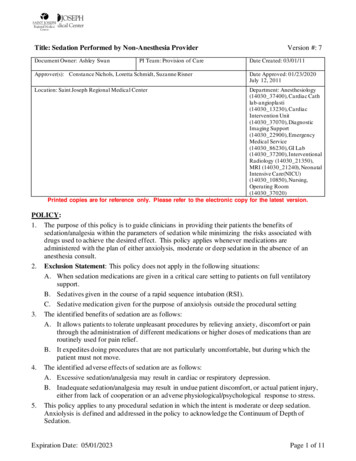
Transcription
Title: Sedation Performed by Non-Anesthesia ProviderDocument Owner: Ashley SwanPI Team: Provision of CareApprover(s): Constance Nichols, Loretta Schmidt, Suzanne RisnerVersion #: 7Date Created: 03/01/11Date Approved: 01/23/2020July 12, 2011Location: Saint Joseph Regional Medical CenterDepartment: Anesthesiology(14030 37400), Cardiac Cathlab-angioplasti(14030 13230), CardiacIntervention Unit(14030 37070), DiagnosticImaging Support(14030 22900), EmergencyMedical Service(14030 86230), GI Lab(14030 37200), InterventionalRadiology (14030 21350),MRI (14030 21240), NeonatalIntensive Care(NICU)(14030 10850), Nursing,Operating Room(14030 37020)Printed copies are for reference only. Please refer to the electronic copy for the latest version.POLICY:1. The purpose of this policy is to guide clinicians in providing their patients the benefits ofsedation/analgesia within the parameters of sedation while minimizing the risks associated withdrugs used to achieve the desired effect. This policy applies whenever medications areadministered with the plan of either anxiolysis, moderate or deep sedation in the absence of ananesthesia consult.2. Exclusion Statement: This policy does not apply in the following situations:A. When sedation medications are given in a critical care setting to patients on full ventilatorysupport.B. Sedatives given in the course of a rapid sequence intubation (RSI).C. Sedative medication given for the purpose of anxiolysis outside the procedural setting3. The identified benefits of sedation are as follows:A. It allows patients to tolerate unpleasant procedures by relieving anxiety, discomfort or painthrough the administration of different medications or higher doses of medications than areroutinely used for pain relief.B. It expedites doing procedures that are not particularly uncomfortable, but during which thepatient must not move.4. The identified adverse effects of sedation are as follows:A. Excessive sedation/analgesia may result in cardiac or respiratory depression.B. Inadequate sedation/analgesia may result in undue patient discomfort, or actual patient injury,either from lack of cooperation or an adverse physiological/psychological response to stress.5. This policy applies to any procedural sedation in which the intent is moderate or deep sedation.Anxiolysis is defined and addressed in the policy to acknowledge the Continuum of Depth ofSedation.Expiration Date: 05/01/2023Page 1 of 11
Title: Sedation Performed by Non-Anesthesia Provider6.7.8.Version #: 7Authority and oversight of sedation is the responsibility of the Chair of the Department ofAnesthesia or their designee. The Anesthesia Chair participates in the development of policy, casereview and resolution of any policy issues.Departments in which moderate or deep sedation are used are responsible for assuring that a qualitymonitoring process is in place which allows for positive patient outcomes through the analysis ofdata and implementation of interventions. The Department of Anesthesia has responsibility forreviewing all quality data. The use of reversal agents must always be tracked and reported. Otherevents that may require reporting and review are an unplanned admission, cardiac arrest, use ofassistance with ventilation (bag-valve-mask ventilation or laryngeal or endotracheal airways,prolonged periods of oxygen desaturation ( 85% for 3 minutes), and failure to return patient to20% of preprocedure vital signs.Sedation will be defined according to American Society of Anesthesiologists Standard (ASA) asfollows:CONTINUUM OF DEPTH OF SEDATION:DEFINITION OF GENERAL ANESTHESIA AND LEVELS OF SEDATION/ANALGESIA*Committee of Origin: Quality Management and Departmental Administration(Approved by the ASA House of Delegates on October 27, 2004, and amended on October 21, 2009)Minimal SedationAnxiolysisModerate Sedation/Analgesia“Conscious Sedation”ResponsivenessNormal Response toverbal stimuliPurposeful** response toverbal or tactile stimuliAirwayUnaffectedNo intervention requiredSpontaneous tedAdequateUsually maintainedDeep Sedation/AnalgesiaPurposeful**response followingrepeated or painfulstimuliIntervention maybe requitedMay be inadequateUsually maintainedGeneral AnesthesiaUnarousable even withpainful stimuliIntervention often requiredFrequently inadequateMay be impairedCONTINUUM OF DEPTH OF SEDATION:DEFINITION OF GENERAL ANESTHESIA AND LEVELS OF SEDATION/ANALGESIA* (continued)Committee of Origin: Quality Management and Departmental Administration(Approved by the ASA House of Delegates on October 27, 2004, and amended on October 21, 2009)Minimal Sedation (Anxiolysis) is a drug-induced state during which patients respond normally to verb al commands. Althoughcognitive function and physical coordination may be impaired, airway reflexes, and ventilatory and cardiovascular functions a reunaffected.Moderate Sedation/Analgesia (“Conscious Sedation”) is a drug-induced depression of consciousness during which patientsrespond purposefully** to verbal commands, either alone or accompanied by light tactile stimulation. No interventions are req uired tomaintain a patent airway, and spontaneous ventilation is adequate. Cardiovascular function is u sually maintained.Deep Sedation/Analgesia is a drug-induced depression of consciousness during which patients cannot be easily aroused but respondpurposefully** following repeated or painful stimulation. The ability to independently maintain ventilatory function may be impaired.Patients may require assistance in maintaining a patent airway, and spontaneous ventilation may be inadequate. Cardiovascularfunction is usually maintained.Expiration Date: 05/01/2023Page 2 of 11
Title: Sedation Performed by Non-Anesthesia ProviderVersion #: 7General Anesthesia is a drug-induced loss of consciousness during which patients are not arousable, even by painful stimulation. Theability to independently maintain ventilatory function is often impaired. Patients often require assistance in maintaining a patentairway, and positive pressure ventilation may be required because of depressed spontaneous ventilation or drug-induced depression ofneuromuscular function. Cardiovascular function may be impaired.Because sedation is a continuum, it is not always possible to predict how an individual patient will respond. Hence, p ractitionersintending to produce a given level of sedation should be able to rescue*** patients whose level of sedation becomes deeper th aninitially intended. Individuals administering Moderate Sedation/Analgesia (“Conscious Sedation”) should be able to rescue*** patientswho enter a state of Deep Sedation/Analgesia, while those administering Deep Sedation/Analgesia should be able to rescue*** p atientswho enter a state of General Anesthesia.* Monitored Anesthesia Care does not describe the continuum of depth of sedation; rather it describes “a specific anesthesiaservice in which an anesthesiologist has been requested to participate in the care of a patient undergoing a diagnostic ortherapeutic procedure.”** Reflex withdrawal from a painful stimulus is NOT considered a purposeful response.*** Rescue of a patient from a deeper level of sedation than intended is an intervention by a practitioner proficient in airw aymanagement and advanced life support. The qualified practitioner corrects adverse ph ysiologic consequences of the deeperthan-intended level of sedation (such as hypoventilation, hypoxia and hypotension) and returns the patient to the originallyintended level of sedation. It is not appropriate to continue the procedure at an unintended level of sedation.9.Medications:A. Refer to addendum 1 of this policy, Sedation Medication Administration Guidelines for thepharmacokinetics, dose and administration, precautions, contraindications, and side effects ofthese medications.B. The physician will determine the medication and dosage to be administered.C. Medications administered for sedation will be determined through patient assessment and willtake into consideration medication allergies, current medication regime, any documentedmedication intolerances, and the patient’s ability to maintain a patent airway.D. All medications administered for the purpose of sedation will be titrated to desired effect.E. Reversal agents will be kept readily available in every area in which sedation is administered orpatients are recovered.1) Reversal agents should only be given in the event of an over-sedation.2) All instances of reversal agent use should be reported through the hospital reportingsystem. Data will be reviewed by the Department of Anesthesia.F. Anxiolysis Medications include:1) Diazepam (Valium)2) Lorazepam (Ativan)3) Midazolam (Versed)G. Moderate Sedation Medications include:1) Lorazepam (Ativan)2) Midazolam (Versed)3) Morphine4) Fentanyl (Sublimaze)5) Hydromorphone (Dilaudid)6) Ketamine (Ketalar)Expiration Date: 05/01/2023Page 3 of 11
Title: Sedation Performed by Non-Anesthesia ProviderVersion #: 7H. Deep Sedation Medication only to be used by practitioners credentialed for deep sedation oranesthesia include:1) Methohexital (Brevital)2) Etomidate3) Propofol (Diprovan)a) Indications: Propofol is used for brief painful procedures, e.g. joint/fracturereductions, dislocations, cardioversions.4) Dexmedetomidine (Precedex)5) Ketamine (Ketalar)I.Reversal Agents include:1) Naloxone (Narcan)2) Flumazenil (Romazicon)10. Approved Clinical Sites:A. Moderate Sedation: Surgical Services, Emergency Department, Cardiac CatheterizationLab/Interventional Radiology, CIU, Diagnostic Radiology, MRI Center, GI/Endoscopy Lab,Pediatrics, NICU, and Critical Care.B. Deep Sedation: Emergency Department, Cardiac Catheterization, Critical Care, CIU.11. Credentialing, privileging, education, and competency of staff:A. Physicians:1) Physicians performing sedation will practice within the guidelines outlined in this policyincluding Addendum 1, Sedation Medication Administration Guidelines.2) Sedation must be administered under the direct supervision of a privileged physician.Privileging is achieved by fulfilling the requirements established by the Medical Staff.Monitoring of the privileging status of physicians is the responsibility of the Medical Staff.a) Anxiolysis (minimal sedation)—No specific credentialing requirementsb) Moderate sedation –credentialing is attached to procedure credentialing. If aphysician is credentialed to perform a procedure, they are also credentialed inadministration of the associated moderate sedation.c) Deep sedation –specific specialties, by merit of their core competency, will qualify tohave deep sedation added as a line item credentialed privilege. Examples includeEmergency Physicians and Cardiologists.d) General anesthesia is a core privilege for Anesthesiologists.3) Administration means overseeing the process of sedation.4) Direct Supervision for administering moderate and deep sedation is defined as having aprivileged physician physically present in the room and prepared to provide emergentairway and ventilatory support as needed.B. Nursing:1) Registered Nurses are deemed competent in sedation upon completion of the annualcompetency requirements as defined below:Expiration Date: 05/01/2023Page 4 of 11
Title: Sedation Performed by Non-Anesthesia ProviderVersion #: 72) Completion of I-Learn Module entitled: Sedation Moderate/Analgesia (ConsciousSedation).3) Completion of a written test on medications. There is a specific test for each level ofcompetency:a) Moderate sedationb) Deep sedationc) Pediatric sedation4) Demonstration of skills:a) In clinical setting w/preceptor orb) In simulation lab (unit based)5) Current certification in ACLS and/or PALS and/or NRP as appropriate.6) In addition, a competent nurse is able to:a) Operate and troubleshoot all necessary equipment.b) Demonstrate an understanding of the pharmacology (use, side effects, andcomplications) of sedative agents and their antagonists.7) Identify EKG changes from baseline on the monitoring strips.8) Establish a patent airway and positive pressure ventilation.9) Registered Nurses may give meds under direction of credentialed MD who is present at thebedside.10) A competent RN shall be assigned to monitor the patient throughout the sedationprocedure. The level of qualification must be appropriate to the planned level of sedation11) This nurse may assist others with interruptible ancillary tasks of short duration during theprocedure if appropriate.12. History and Physical:A. A complete history and physical examination (as defined in Medical Staff policy) shall be onthe medical record prior to any patient receiving moderate sedation in either the inpatient oroutpatient setting.B. Appropriate candidates for conscious or deep sedation should be determined after a thoroughhistory and examination that includes an airway assessment.C. An airway assessment using the Mallampati Airway Classification system is required.a) Anesthesia is consulted if the physician planning to administer sedation has concernsabout the ability to manage the patient airway due to anatomic or physiologicconsiderations.Expiration Date: 05/01/2023Page 5 of 11
Title: Sedation Performed by Non-Anesthesia ProviderExample of Mallampati ClassI- patient sits upright- head in neutral position- open mouth as wide aspossible- protrudes tongue- soft palate- anterior, posterior tonsillarpillars are visible- uvula visible - all of itVersion #: 7http://vdmtc.org/module01/anatomy/mod01f ig06.jpgExample ofExample of Mallampati Class III- only the soft palate is visible- a difficult intubation is predicted- consider awake intubationMallampati Class IV- the soft palate is notvisible-a difficult intubation ispredicted-consider awakeintubationExample of MallampatiClass II- tonsillar pillars and tip ofuvula hidden by baseof tongueD. Assignment of a risk classification using ASA Physical Status Classification.1) The physician who orders the sedation is responsible for assigning the patient an ASAclassification.2) Members of the sedation team must be in agreement with the classification prior toproceeding with the sedation/procedure.3)Any member of the sedation/procedural team may request anesthesiaevaluation/input prior to the procedure if there is a lack of consensus on ASAstatus and patient fitness for sedation. The procedure will not take place until aconsensus is reached.4) ASA Class P4 and P5 must receive an Anesthesia consult prior sedation/procedure unless thesituation is deemed emergent. This will require supporting documentation of the nature of theemergency by the sedating physician.ASA Physical Classification SystemASA Physician Status 1 - A normal healthy patientASA Physician Status 2 - A patient with mild systemic diseaseASA Physician Status 3 - A patient with severe systemic diseaseASA Physical Status 4 - A patient with severe systemic disease that is a constant threat to lifeASA Physician Status 5 - A moribund patient who is not expected to survive without the operationASA Physician Status 6 - A declared brain-dead patient whose organs are being removed for donor purposesThese definitions appear in each annual edition of the ASA Relative Value Guide. There is no additionalinformation that will help you further define these categories.PROCEDURE:A. Informed Consent:1) The patient/guardian must be informed about the risks, benefits and alternatives of sedation asa component of the planned procedure.Expiration Date: 05/01/2023Page 6 of 11
Title: Sedation Performed by Non-Anesthesia ProviderVersion #: 72)Consent for Procedures/Sedation and Other Medical Services (form #6002) must be completedand signed prior to initiation of the sedation/procedure.B. Pre-Procedure Requirements:1)1)Clinicians administering sedation shall be familiar with and document relevant aspects of thepatient’s medical history to include:a)Abnormalities of the major organ systems, including a neurological, cardiac, andrespiratory assessment. (The sedating physician must complete and document)b)Previous adverse experience with sedation, as well as general and regional anesthesiac)Current medications and drug allergiesd)Actual weight unless medical status prohibits this measurement. An exact weight isrequired for pediatric patients.e)The patient shall typically be seen in the preop area rather than the procedural suitethereby allowing adequate access for evaluation should anesthesia involvement bedetermined necessary.Review and documentation of the following is also required:a)b)Any pertinent pre-procedure diagnostic tests. Pre-procedural testing is driven by thepatient’s pre-existing medical conditions and by the likelihood that the results will affectthe management of sedation.Nothing by mouth (NPO) status. For elective cases, see for ASA recommendations. Inemergent situations, the risks associated with recent oral intake mustASA Guidelines for Preoperative FastingIngested Material Minimum Fasting PeriodClear liquids32hBreast milk4hInfant formula6hNon-human milk 46hLight meal56h21 These recommendations apply to healthy patients who are undergoing elective procedures. They are not i ntended for women in labor. Following the guidelines does not guarantee complete gastric emptying.2 The fasting periods noted below apply to all ages.3 Examples of clear liquids include water, fruit juices without pulp, carbonated beverages, clear tea, and black coffee.4 Since non-human milk is similar to solids in gastric emptying time, the amount ingested must be considered when determining an appropriate fasting period.5 A light meal typically consists of toast and clear liquids. Meals that include fried or fatty foods or meat may prolong gastric emptying time. Additional fasting time ( e.g., 8 or more hours) may be needed in thesecases. Both the amount and type of foods ingested must be considered when determining an appropriate fasting period.2)Prior to procedure a baseline assessment of the following parameters is measured anddocumented:a)Respiratory rate and patternb)Oral/temporal artery temperaturec)Oxygen saturationd)Skin color and temperaturee)Level of consciousness/orientation (age appropriate)f)Blood pressure (Optional for pediatric patients)Expiration Date: 05/01/2023Page 7 of 11
Title: Sedation Performed by Non-Anesthesia ProviderVersion #: 7g)Heart rate and rhythm-- A baseline EKG strip is placed in the medical record. (Optionalfor pediatric patients)3) IV access is established. Exception: pediatric patients for whom sedation is accomplishedwith oral medications.4) Pre-procedure education is documented5) For elective outpatients, availability of a responsible adult to drive patient home and care forthem is documented. Failure to establish this requirement will result in the procedure beingrescheduled at a time when this resource is available.6) All pre-procedural components of Universal Protocol policy, Universal Protocol forPreventing Wrong Site, Wrong Procedure, and Wrong Person Surgery.B. Intra-Procedure Requirements:1) The following equipment will be used on every patient:a)Pulse oximetryb)Suction will be readily available at the bedsidec)EKG monitor (Optional for pediatric patients)d)Blood pressure monitor (Optional for pediatric patients)e)Capnography2) Optional equipment dependent upon setting, procedure performed, physician order, patientpositioning:a)Pre-oxygenation with 2 lpm nasal cannula or as ordered by the sedating physician3) The following equipment/supplies will be available in the immediate area duringadministration of sedation:a)Oxygen delivery devicesb)Ambu bags and airwaysc)IV supplies/equipmentd)Crash cart with cardiac monitor/defibrillator (Pediatrics: Braselow cart)e)Pulse oximeterf)Continuous EKG monitoringg)Blood Pressure monitorh)Suctioni)Reversal Agentsj)Means for summoning assistance4) Medication Management:a)All medications used for sedation will be ordered electronically using physiciancomputerized order entry (CPOE). Depending on the area, individual doses may becharted on a specialty flow sheet at the time of administration and the total dose of eachmedication recorded on the electronic medication administration record (eMAR) at theend of the procedure.b)Reversal agent for each type of sedation administered will be immediately available.Expiration Date: 05/01/2023Page 8 of 11
Title: Sedation Performed by Non-Anesthesia ProviderVersion #: 7c)d)5)6)Use of oxygen will be ordered using CPOE and documented.IV access will be maintained until the patient is no longer at risk for cardio/respiratorydepression. IV access will be re-established if needed due to loss of access or prematurediscontinuation.Patient Monitoring:a)Perform and document all components of Universal Protocol policy, Universal Protocolfor Preventing Wrong Site, Wrong Procedure, and Wrong Person Surgery.b)The sedating nurse will document baseline values of all parameters: heart rhythm, pulse,respirations, blood pressure, oxygen saturation, ETCO2, skin color/temp, Ramsay score,and Aldrete score.c)The patient’s ventilatory and oxygenation status and vital signs will be monitoredcontinuously during the sedation procedure and documented every 5 minutes.d)Ramsay score and skin color/temp will be monitored through the procedure anddocumented every 15 minutes.e)EKG rhythm will be documented post procedure only if there is a change from baseline.f)Document each dose of medication, dose, route, and effect.g)Document responses to all interventions.h)Document the start and stop time of procedure and sedation.i)The use of reversal agents at any point during procedure should be communicated to thenext level of care and documented as follows:(1) eMAR(2) Significant Events notes(3) Handoff formPost-Procedure Requirements:a)At the end of the procedure, the following criteria must be met to terminate the sedationprocedure:(1) Arousable, easily re-oriented, neurologically stable or baseline(2) Airway, breathing, and circulation have returned to baseline(3) Patient is comfortable and pain is managed(4) Aldrete I score must be assessed and documented at the end of the procedure.(a) If 8 or pre-procedure value, patient may return to their pre-proceduresetting or Postop/Phase II for ambulatory patients.(b) If or equal to 8, patient must remain monitored in the procedural settinguntil score allows transfer or patient must be taken to PACU. If decision ismade to transfer to PACU:[1] PACU must be alerted to patient arrival and complete handoff given uponarrival.[a] The sedating physician must write PACU orders in addition to post–procedure /discharge orders as applicable.Expiration Date: 05/01/2023Page 9 of 11
Title: Sedation Performed by Non-Anesthesia ProviderVersion #: 7[b] Patients who have received reversal agents during or immediatelyfollowing the procedure should be placed in a setting that allows closeobservation and monitoring for a minimum of 2 hours post procedure.[2] Plymouth Campus - If Aldrete I score is or equal to 8, the patient will betransferred to the Critical Care Unit.C. Post Procedure Requirements:1) Upon return to the inpatient or ambulatory postop/phase II unit, vital signs, oxygen saturationand Aldrete II are documented as outlined in Nursing Policy, Assessment.2) Outpatients may be discharged when criteria are met:a) Vital signs stable for at least ½ hour prior to discharge (2 hours if reversal agent given)b) Swallows and coughsc) Maintains respiratory functiond) Minimal nausea, dizziness, or vomitinge) Effective pain managementf) Oriented to person, place, and timeg) Ambulates consistent with age and surgical procedureh) Minimal bleeding or drainage from surgical sitei) Return of normal sensation (spinal/ epidural anesthesia)j) Voids spontaneously (spinal/ epidural anesthesia)k) Extremities pink and warm; pulses, sensation and movement present (extremityprocedures).l) Abdomen soft, no severe abdominal pain, no covert bleeding (sigmoid / colonoscopyprocedures)m) Swallows, no epigastric pain (EGD procedures)n) Patient and/or significant other adult given verbal and written discharge instructionsRelated Documents: Sedation Monitoring Flowsheet (downtime Form)Definitions: See definitions in body of policyReferences/Standards: ASA House of Delegates. Continuum of depth of sedation: definition of general anesthesia andlevels of sedation/analgesia. (2009). ASA House of Delegates. Statement on granting privileges for deep sedation to non-anesthesiologistsedation practitioners. (2010). ASA House of Delegates. Statement on granting privileges to nonanesthesiologist practitioners forpersonally administering deep sedation or supervising deep sedation by individuals who are notanesthesia professionals. (2006). ASA House of Delegates. Statement on safe use of propofol. (2009). Comprehensive Accreditation Manual for Hospitals, January 2010. Provision of Care, Treatment,and Services Standards PC.03.01.01-PC.03.01.05.Expiration Date: 05/01/2023Page 10 of 11
Title: Sedation Performed by Non-Anesthesia Provider Version #: 7Department of Health & Human Services, Centers for Medicare & Medicaid Services. (2010).Revised hospital anesthesia services interpretive guidelines.Gross, J.B. (2002, et al. Practice guidelines for sedation and analgesia by non-anesthesiologists.Anesthesiology, 96(4), 1004-1017.Odom-Forren, Jan and Watson, Donna, Practical Guide to Moderate Sedation/Analgesia, 2nd ed.,Elselvier Mosby, St. Louis Missouri, 2005.2015-2017 Perianesthesia Nursing Standards and Practice Recommendations, American Society ofPerianesthesia Nurses, Cherry Hill, New Jersey, 2010.2015 Perioperative Standards and Recommended Practices, Association of Perioperative RegisteredNurses, Inc., Denver, CO 2011Expiration Date: 05/01/2023Page 11 of 11
Title: Sedation Performed by Non-Anesthesia Provider Version #: 7 Expiration Date: 05/01/2023 Page 5 of 11 2) Completion of I-Learn Module entitled: Sedation Moderate/Analgesia (Conscious Sedation). 3) Completion of a written test on medications. There is a specific test for each level of competency: a) Moderate sedation b) Deep sedation



